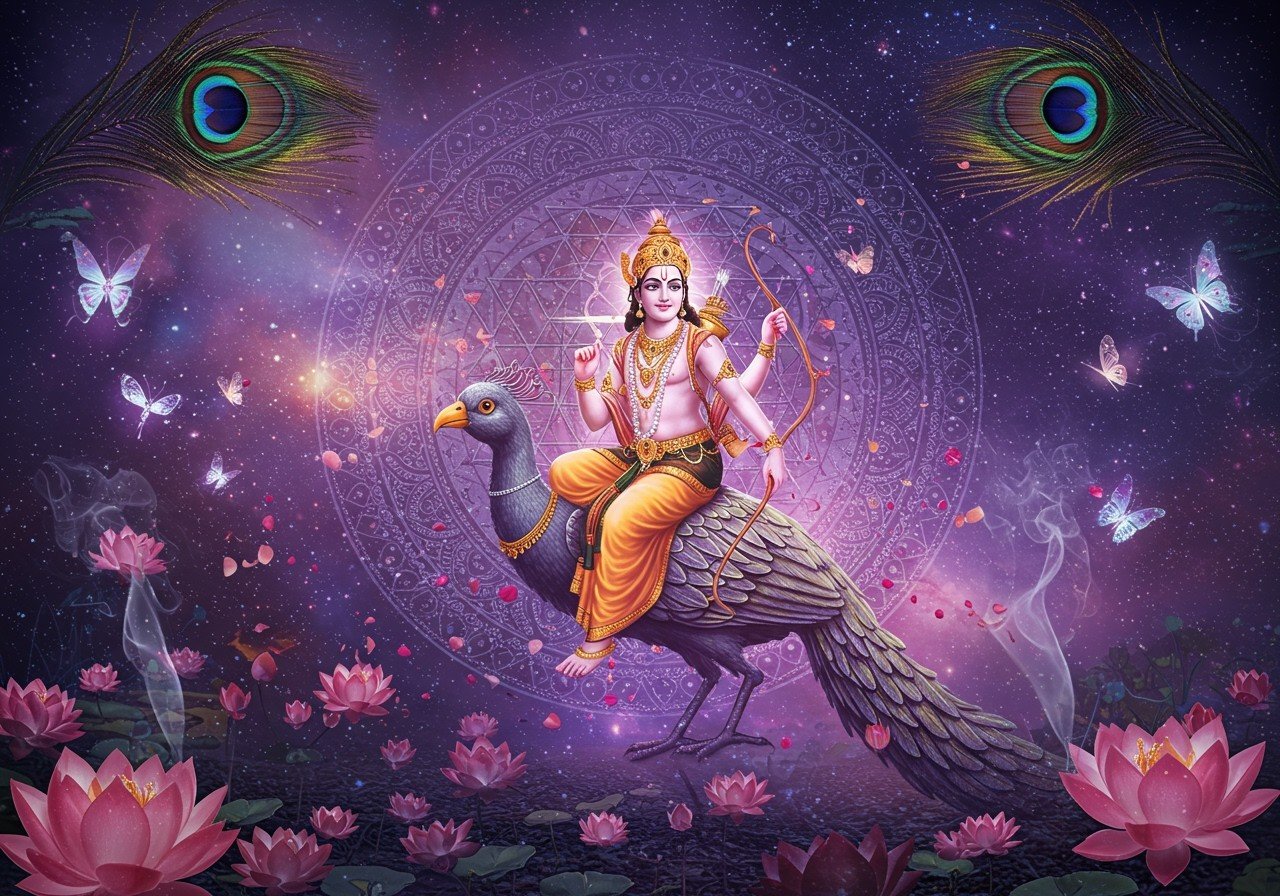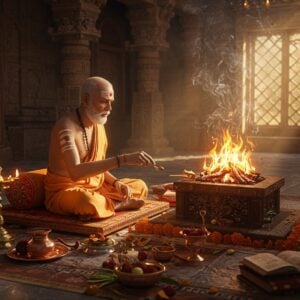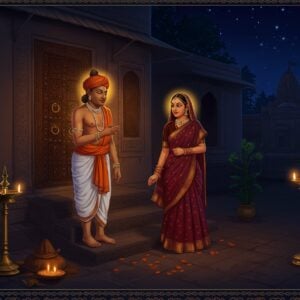Kamadeva: Exploring Love’s Deity in 2025

Kama holds a special place in Indian tradition, symbolizing desire and passion. This article explores Kama’s meaning, its personification through Kamadeva, and the rich cultural narratives of Kama and Rati. Discover how these themes resonate with modern Indians who appreciate tradition and the ease of online shopping for puja samagri and other spiritual products. You can find a wide variety of authentic puja items on poojn.in, India’s largest online store for cultural goods and services.
Understanding Kama
Kama is one of the four Purusharthas in Hindu philosophy, representing desire, wish, and passion. It encompasses a wide spectrum of human experiences, from appreciating art and culture to the experience of sensual pleasure. While Kama is a driving force behind creativity and enjoyment, it can also be a source of distraction or attachment if not managed mindfully. Kama is not solely focused on physical desire; it also includes the pursuit of beauty, artistic expression, and cultural appreciation. This makes Kama a complex and multifaceted concept with profound implications for human life.
Kama stands alongside the other Purusharthas: Dharma (duty), Artha (wealth), and Moksha (liberation). Each Purushartha plays a vital role in maintaining balance and purpose in life. Understanding Kama helps individuals navigate the interplay of duty and pleasure, making it incredibly relevant in daily life and decision-making. It provides a framework for pursuing desires in a way that aligns with one’s values and responsibilities.
Kamadeva: The Deity of Love
Kamadeva is the Hindu god of love and desire, typically portrayed as a youthful figure wielding a sugarcane bow and arrows tipped with fragrant flowers. The sugarcane bow symbolizes the sweetness and intoxicating nature of love, while the flower arrows represent the fragility and fleeting nature of desire. Kamadeva plays a pivotal role in various mythological stories, including the famous tale of awakening Shiva from his deep meditation. Accompanied by Rati, his consort, they represent the combined power of love and passion.
Kamadeva’s influence is evident in art, literature, and even in the celebration of certain festivals. His stories offer profound insights into the nature of love, desire, and the human experience. In contemporary times, Kamadeva’s myths continue to provide valuable lessons, helping individuals balance tradition with the demands and opportunities of modern life. They offer a framework for understanding and navigating the complexities of relationships and emotions.
Kama and Rati: The Divine Couple
Rati, the goddess of love and pleasure, stands alongside Kamadeva as his consort. They embody the harmony and balance of love. Their combined presence in Hindu mythology underscores the importance of both emotional connection and physical attraction in healthy relationships. Stories of Kama and Rati often depict celestial trials and victories, symbolizing the challenges and triumphs that love can bring. Their narratives offer valuable insights into navigating the complexities of relationships.
Festivals like Vasant Panchami honor this divine couple by celebrating the arrival of spring and the renewal of love in the natural world. The stories of Kama and Rati have profoundly shaped modern perspectives on relationships and the expression of love in India. These narratives continue to provide guidance and inspiration for building strong, loving connections in contemporary life.
These divine narratives provide profound teachings about the true nature of desire and its fulfillment, resonating deeply within Indian society and continuing to influence contemporary views on love and relationships.
Kamadeva’s Symbolism and Significance
Kamadeva, also known as Madana and Manmatha, embodies love, desire, attraction, pleasure, and beauty. He is the personification of “kāma,” which translates to “desire” or “longing,” particularly in the context of sensual or sexual love. His rich symbolism and mythology offer profound insights into the complexities of human connection.
Appearance and Iconography
- Appearance: Kamadeva is depicted as a handsome youth, often with a greenish or reddish complexion, sometimes adorned with golden wings. This youthful image captures the vibrant and often transient nature of love and desire, symbolizing its power to uplift and transform. His radiant appearance also reflects the beauty and allure associated with love.
- Bow and Arrows: His iconic sugarcane bow and flower-tipped arrows represent love’s multifaceted nature. The sugarcane signifies sweetness, pleasure, and the mind’s susceptibility to love’s influence. The bowstring, often depicted as a string of humming honeybees, symbolizes the intoxicating and captivating nature of desire. The five flower-tipped arrows correspond to the five senses and evoke various emotional states associated with love and longing. These flowers typically include Ashoka, white and blue lotus, jasmine, and mango blossoms, each carrying its own symbolic meaning related to love, beauty, and sensuality. Together, they represent the diverse ways love can touch and transform us.
- Parrot and Makara: Kamadeva’s association with the parrot symbolizes communication, highlighting the importance of words and expressions in love. The parrot’s ability to mimic sounds represents the way love can echo and amplify emotions, fostering deeper connection. The Makara, a mythical sea creature, also appears in Kamadeva’s iconography, adding an element of mystery and otherworldly charm. The Makara’s connection to water symbolizes the fluidity and depth of emotions associated with love and desire.
- Companions: Kamadeva is often accompanied by his consort, Rati, the goddess of passion and desire. Their union signifies the harmonious interplay of love and longing. He is also associated with Vasanta, the god of spring, and celestial beings like Apsaras, Gandharvas, and Kinnaras, all symbolizing the joyous and celebratory aspects of love, beauty, and the arts.
Mythological Narratives
- Origins: Kamadeva’s origins vary across different scriptures. Some Puranas describe him as born from the mind of Brahma, the creator god. Others identify him as the son of Lakshmi and Vishnu or as an incarnation of Krishna. In the Mahabharata, he is portrayed as the son of Dharma, representing the rightful place of desire within a moral framework. This diversity in origin stories reflects the complex and evolving understanding of love and desire within Hindu tradition. They showcase how different philosophical schools and narratives have integrated Kamadeva into their understanding of the cosmos and human existence.
- Incineration by Shiva: A pivotal myth revolves around Kamadeva’s attempt to awaken Shiva from deep meditation. Tasked by the gods to ensure Shiva would father a son capable of defeating a powerful demon, Kamadeva aimed his love arrow at the meditating deity. Enraged by the interruption, Shiva opened his third eye and incinerated Kamadeva, reducing him to ashes. This act, while destructive, ultimately served its purpose. Shiva’s awakened passion led to his union with Parvati and the birth of Kartikeya, the prophesied warrior god. This story highlights the immense power of desire, even in the face of divine wrath, and its potential to both create and destroy.
- Rebirth as Pradyumna: After his incineration, Kamadeva was reborn as Pradyumna, the son of Krishna and Rukmini. This rebirth signifies the cyclical nature of desire and its enduring presence in the universe. It also underscores the idea that love, even when seemingly extinguished, can find new forms and expressions. Pradyumna’s story continues the theme of love and attraction, further solidifying Kamadeva’s significance in Hindu mythology.
Role and Significance
Kamadeva is revered as the god of love and passion, the force that awakens desire and drives creation. His presence in mythology emphasizes the importance of emotional and physical love as integral aspects of life, contributing to harmony, spiritual growth, and the continuity of life itself. He inspires affection, fosters relationships, and ensures the propagation of life. His influence extends beyond romantic love, encompassing all forms of attraction and desire that enrich human experience.
Worship and Rituals
While Kamadeva lacks major pan-Indian festivals dedicated solely to him, he is honored during specific seasonal and regional observances, particularly during Vasant Panchami and Holi. Devotees offer sandalwood paste and mango blossoms, symbolizing love and sensuality, to invoke his blessings. Prayers to Kamadeva are often made alongside his consort, Rati, through the chanting of mantras, offerings of fragrant flowers, sandalwood, incense, and meditation on his symbols. Sandalwood incense sticks and other puja items can enhance your devotional practices. These rituals offer a way to connect with the divine energy of love and seek blessings for fulfilling relationships and desires.
Poojn.in: Your Source for Puja Needs
For all your puja needs, including items for honoring Kamadeva and Rati, visit poojn.in. As India’s leading online store for cultural and religious goods, poojn.in provides a vast selection of high-quality products, convenient online ordering, and reliable delivery across India. Explore our collection of camphor, murtis, and other essential items for your spiritual practices.
Kamadeva’s Enduring Legacy in 2025
Even in 2025, Kamadeva’s influence remains strong. His symbolism and stories continue to resonate with those seeking to understand and celebrate love, desire, and beauty. He reminds us of the importance of emotional connections and the power of love to inspire and transform. As traditions intertwine with modern life, Kamadeva’s teachings offer valuable guidance for nurturing relationships and finding fulfillment. In a world increasingly reliant on digital platforms, poojn.in bridges the gap, providing easy access to traditional puja items, thus ensuring the preservation of cultural practices. Kamadeva’s legacy endures, reminding us of the enduring power and beauty of love in all its forms.


